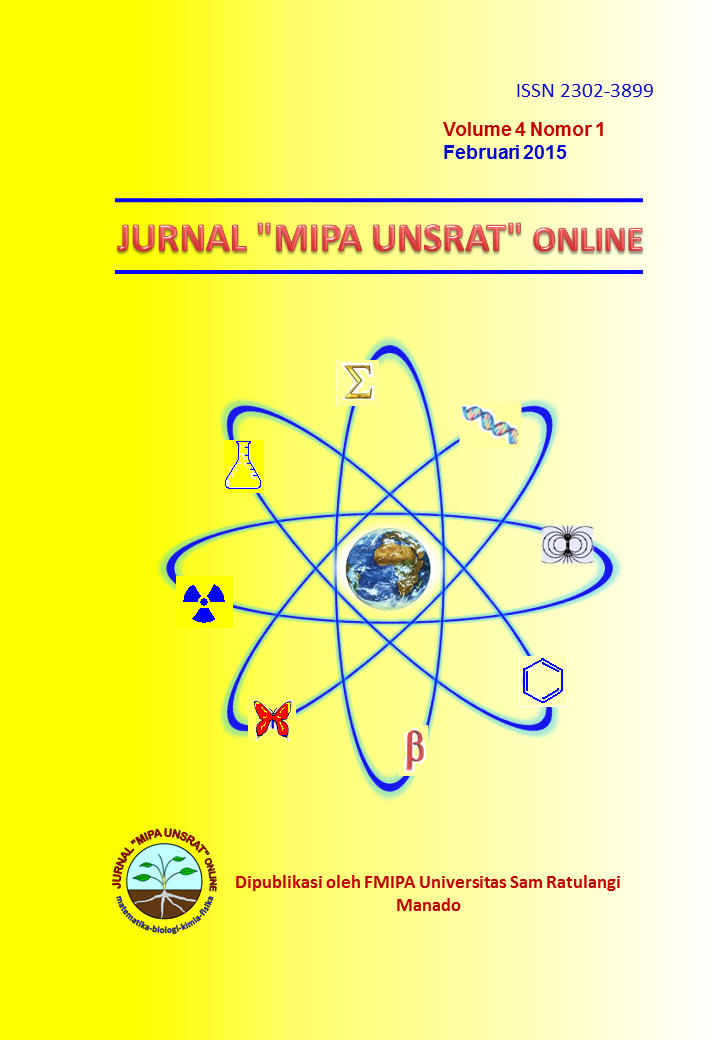Densitas dan Jenis Pakan Burung Rangkong (Rhyticeros cassidix) di Cagar Alam Tangkoko Batuangus
DOI:
https://doi.org/10.35799/jm.4.1.2015.6911Abstract
Penelitian burung rangkong sulawesi sudah banyak dilakukan tetapi informasi mengenai densitas dan jenis pakannya masih sedikit. Tujuan penelitian ini adalah untuk mengetahui densitas dan jenis pakan burung rangkong sulawesi (Rhyticeros cassidix) di Cagar Alam Tangkoko Batuangus, Sulawesi Utara. Penelitian ini dilaksanakan pada bulan Juni-Agustus 2014. Penelitian ini menggunakan metode garis transek (Transek Line) yang berjumlah 3 garis transek dengan panjang 2 km dan lebar transek 400 m, mulai dari ketinggian 11-208 m dpl. Hasil Penelitian ini menunjukan densitas tertinggi berada pada T2 dengan jumlah 47 ekor/km2, dan terendah pada T1 31 ekor/km2, dengan densitas rata-rata 37 ekor/ km2. Hasil pengamatan mendapatkan 13 jenis makanan burung rangkong, yang meliputi 8 jenis buah dan 5 jenis serangga. Burung rangkong Sulawesi mengkonsumsi buah dan serangga, seperti buah beringin (Ficus benjamina), Asar mampuduar (Ficus virens), pohon dewan (Ficus altissima), Ficus caulocarpa, karet kerbau (Ficus elastic), kayu ara (Ficus tinctoria), pohon rao (Dracotomelon dao), kananga (Cananga odorata) dan jenis serangga seperti, kumbang tanduk (Oryctes rhinoceross), kumbang tanduk panjang (Batocera numitor), kumbang kelapa (Rhynchophorus vulneratus), kumbang tanduk rusa (Odontolabis bellicose), belalang (Valanga nigricornis).
There are many researches about Sulawesi Hornbill have been done but only few information about its density and type of food is available. The purpose of this study was to determine the density and type of food of Sulawesi hornbill (Rhyticeros cassidix) in Batuangus Tangkoko Nature Reserve, North Sulawesi. This study was conducted in June-August 2014. This study used three transect lines with a length of 2 km, a width of 400 m, and an altitude of 11-208 m above sea level. The results of this study showed the highest density was at T2 which is 47 head / km2 and the lowest at T1 which is 31 individuals / km2. The average density is 37 individuals / km2. From the observation 13 kinds of food hornbill were found included eight kinds of fruit and five species of insects. Sulawesi hornbill eats fruits and insects, such as figs (Ficus benjamina), Asar mampuduar (Ficus virens), boards tree (Ficus altissima), Ficus caulocarpa, buffalo rubber (Ficus elastic), wood fig (Ficus tinctoria), tree rao (Dracotomelon dao), Kananga (Cananga odorata) and insects such as horn beetle (Oryctes rhinoceross), long-horn beetle (Batocera numitor), palm weevils (Rhynchophorus vulneratus), deer horn beetle (Odontolabis bellicose), grasshoppers (Valanga nigricornis).
There are many researches about Sulawesi Hornbill have been done but only few information about its density and type of food is available. The purpose of this study was to determine the density and type of food of Sulawesi hornbill (Rhyticeros cassidix) in Batuangus Tangkoko Nature Reserve, North Sulawesi. This study was conducted in June-August 2014. This study used three transect lines with a length of 2 km, a width of 400 m, and an altitude of 11-208 m above sea level. The results of this study showed the highest density was at T2 which is 47 head / km2 and the lowest at T1 which is 31 individuals / km2. The average density is 37 individuals / km2. From the observation 13 kinds of food hornbill were found included eight kinds of fruit and five species of insects. Sulawesi hornbill eats fruits and insects, such as figs (Ficus benjamina), Asar mampuduar (Ficus virens), boards tree (Ficus altissima), Ficus caulocarpa, buffalo rubber (Ficus elastic), wood fig (Ficus tinctoria), tree rao (Dracotomelon dao), Kananga (Cananga odorata) and insects such as horn beetle (Oryctes rhinoceross), long-horn beetle (Batocera numitor), palm weevils (Rhynchophorus vulneratus), deer horn beetle (Odontolabis bellicose), grasshoppers (Valanga nigricornis).





